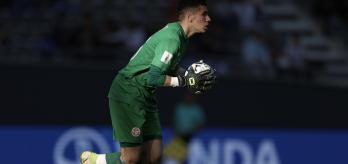Argentina centre-forward Alejo Véliz has scored three goals from headed finishes so far, more than any other player. He is also the top-ranked centre-forward for winning aerial duels (80%) with an average of 7 per match. Andrés Ferrari (URU) is level with Véliz for headed attempts at goal with an average of 2.6 per 90 minutes, and has scored one headed goal so far.
According to Shaun Goater, “Timing is everything with effective centre-forward play. The Number 9 position is unique in that you are expected to make a big impact with as few touches as possible. Timing of runs, knowing which space to occupy, leaving space free that you want to attack, making decoy runs to move defenders so you can create space to attack the ball, and knowing how many touches to take to score, are all part of what defines centre-forward play.”
The relationship and level of understanding between the centre-forward and the players delivering them the ball is also essential.
“When players play together, they develop an understanding and expectation of each other. The centre-forward will learn when and where he is likely to receive the ball from different players and this helps him to time his runs and movements. Players will make eye-contact, or will know certain triggers to play off and often these are developed through time on the pitch together and little chats that they will have,” he added.
Occupying and creating space between defenders
A key aspect of centre-forward play is the ability to come from the blindside of the centre-back, to occupy the space where they cannot see you and to attack the space in front of them.
This awareness is a key strength in how Argentina centre-forward Alejo Véliz plays when he is in the penalty area preparing for aerial deliveries.
It’s an aspect of his game that stands out for Goater. “He is a very agile player and he understands when to occupy space and when to leave it free in order to attack it. He is clever and likes to take up starting positions in the blindspot of the defenders. It’s a standout feature of his game. Véliz’s goal against Guatemala (see clip 1) is a great example of how he does this.
“As the ball progresses in the wide areas, he occupies the space between the recovering right-back and right-centre-back and didn’t have to move very much to score. His positioning and the quality of the delivery were outstanding.”
A similar goal is scored by Brazil centre-forward Leonardo (clip 2), as he also requires minimal movement to score. This is owed to his starting position and the quality of the cross from his team-mate.
MOVEMENTS TO MOVE DEFENDERS AND CREATE SPACE
Another important component for effective centre-forward play is the ability to move defenders in order to create space to attack.
According to Julio González, “How centre-forwards move to get the ball is crucial. They need to move away from defenders and they need to make decoy runs to move defenders and therefore create space to attack. The ability to make a first run to drag a defender away from an area, coupled with a sharp change of direction to exploit the space they have just vacated, is also a fundamental skill for a top-class centre-forward.”
England centre-forward Dane Scarlett has demonstrated the ability to make these types of movements. In the clip below, he consistently occupies two centre-backs. After dropping in to receive the ball between the lines, he makes a committed forward run and continuously adjusts his position, firstly to move a defender and create space, then he gets away from the centre-backs before scoring from a position between them.
Similarly, Uruguay centre-forward (9) Andrés Ferrari shows excellent game and positional awareness in the clip below. As soon as his team wins the ball back, he immediately moves to the blindside of the furthest centre-back. The recovering full-back cannot defend against him as he is too far in front and the centre-back is too far in front of him, leaving him free to score at the back post.
MINIMAL TOUCHES
The ability to score with minimal touches is what separates good centre-forwards from world-class ones. A player that can finish from a cross in one touch is very difficult to defend against.
According to Shaun Goater, “This is the part that really defines the centre-forward. The decision-making in the final moment is key. Do they need two touches to score rather than attempting in just one and missing? Or can they execute the finish required with that first touch instead of taking two? Scoring from headers demands a one-touch finish. In order to do that, so much leading up to the finish has to be right.
“Are they hanging back to come in late? Can they be on the shoulder or in the blind spot, or move in front from there. When they are occupying space, do they stay there to finish? Can they move defenders with decoy runs and exploit the space they leave? There are so many decisions that accumulate to ensure their timing is right to execute a one-touch headed finish. When a player can do this, it is very difficult to defend.”





















